Graves Disease Market Size
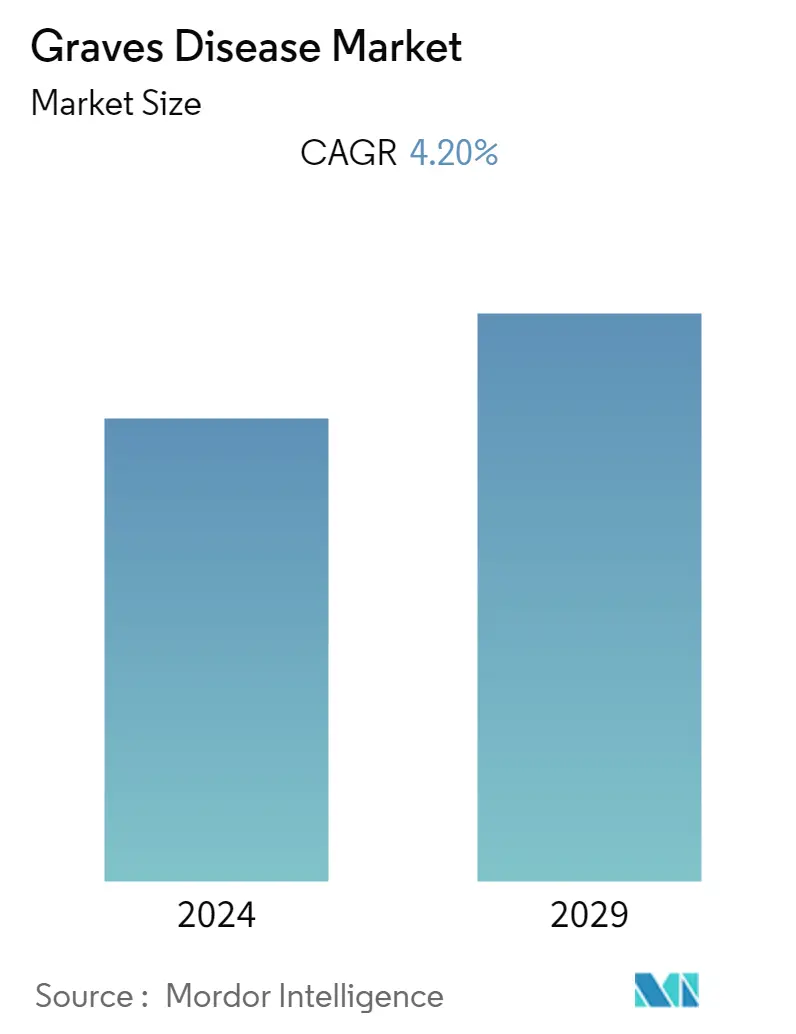
| Study Period | 2019 - 2029 |
| Base Year For Estimation | 2023 |
| Forecast Data Period | 2024 - 2029 |
| CAGR | 4.20 % |
| Fastest Growing Market | Asia-Pacific |
| Largest Market | North America |
Major Players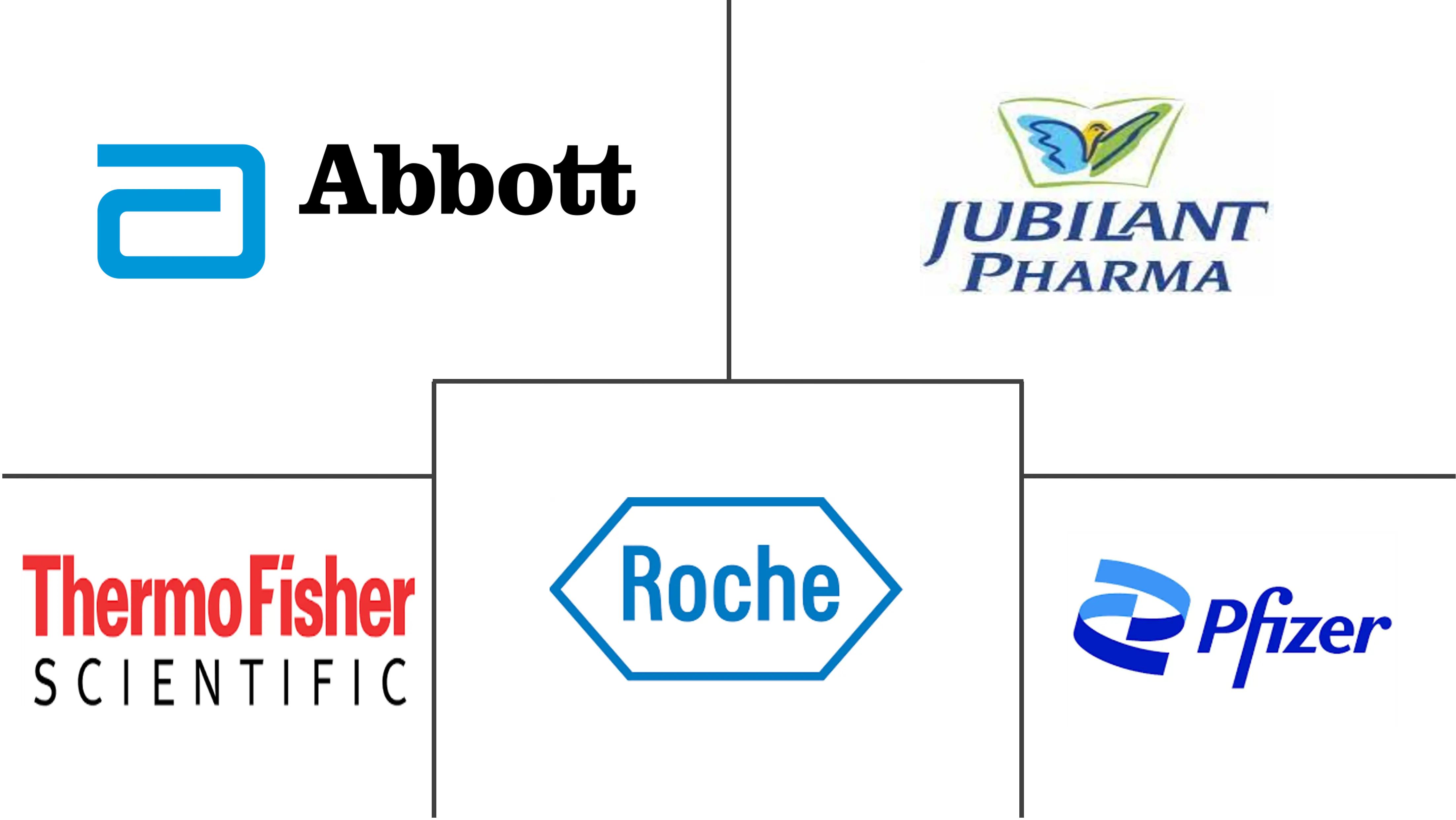
*Disclaimer: Major Players sorted in no particular order |
Graves Disease Market Analysis
The Graves' disease market is expected to register a significant CAGR of 4.2% during the forecast period.
The emergence of the COVID-19 pandemic hurt the world economy and the healthcare system. There is a need to streamline the healthcare process during the COVID-19 times. Due to the COVID-19-led outages, there was a temporary shutdown of the manufacturing plants and a lack of skilled labor, which resulted in supply chain disruptions, impacting the demand and supply of anti-thyroid medications and radioactive iodine, thus impacting the market. Also, due to the rising cases of COVID-19, resources at healthcare facilities were reallocated to the COVID ward, thereby delaying the diagnosis of Graves' disease and hyperthyroidism, thus impacting the market. However, with the increase in vaccination drives and decrease in COVID-19 cases, the diagnosis and therapeutics of GD came to pre-pandemic levels. Additionally, the article 'COVID-19 may trigger Graves' disease relapse, subacute thyroiditis,' published in May 2021, reported that approximately 15% of patients with mild to moderate COVID-19 have thyroid dysfunction, and SARS-CoV-2 may directly affect thyroid morphology and function, worsening preexisting autoimmune thyroid disease. Thus, COVID-19 significantly impacted the market and is expected to impact during the study period.
The factors propelling the studied market growth are the increasing prevalence of hyperthyroidism, rising funding for rare diseases and advancement in treatment technology for effective treatment of Graves' disease is another factor propelling the market growth. Currently, most of the population are adopting sedentary behavior, which is a major cause of thyroid-related diseases, including hyperthyroidism, hypothyroidism, autoimmune diseases, goiter, and others. Additionally, the growing prevalence of smoking, drinking alcohol, and unhealthy foods in developed and developing countries due to sedentary lifestyles lead to serious immune problems such as Graves disease.
According to the Cleveland clinic, in 2022, it has been stated that Graves' disease is one of the most common cause of hyperthyroidism and accounts for around 60% to 80% of hyperthyrodism cases and approximately 1.2% of people in the United States have hyperthyroidism. Thereby, due to this factor there is a need to treat Graves' disease, which in turn is elevating market growth.
Additionally, the study 'Prevalence of hyperthyroidism, hypothyroidism, and euthyroidism in thyroid eye disease: a systematic review of the literature' published in September 2020 estimates global prevalence of hypothyroidism is 10.36%, euthyroidism is 7.9%, and hyperthyroidism is 86.2%. Thus, this high prevalence of thyroid eye disease encourages the research and development activities in the studied market, which will drive the market growth significantly.
Moreover, In April 2022, National Organization for Rare Disorder invested USD 100,000 in grant funding for rare disease research, which will be awarded to qualified researchers to initiate small scientific research studies or clinical trials, the results of which could be used to obtain funding from the National Institutes for Health (NIH), United States Food and Drug Administration (FDA), or other funding agencies, or to attract a corporate sponsor.
However, high costs of treatments and limited reimbursement policies are expected to hinder the market growth during the study period.
Graves Disease Market Trends
Anti-Thyroid Medication Expected to Dominate the Market
In Graves' disease, the immune system creates an abnormal antibody called thyroid-stimulating immunoglobulin. This antibody mimics the function of a normal thyroid-stimulating hormone. It attaches to the surface of thyroid cells and turns on the cells to produce thyroid hormones, leading to the overproduction of these hormones (overactive thyroid). Therefore, there is a demand for anti-thyroid medications which can suppress the activities of the overactive thyroid gland. Therefore, the anti-thyroid medications segment is expected to contribute significantly toward market growth. The anti-thyroid medications include Propylthiouracil (PTU) and Methimazole (Tapazole). These drugs prevent the thyroid from producing excess amounts of the hormone. The growing research proving antithyroid medications' efficacies in treating hyperthyroidism is expected to drive segment growth.
For instance, in the study 'The efficiency and safety of methimazole and propylthiouracil in hyperthyroidism' published in July 2021, methimazole is more efficient than propylthiouracil in patients with hyperthyroidism as the former reduces T3, T4, FT3, and FT4 levels, which results in decreasing the risk of liver function damage and increases the level of thyroid-stimulating hormone. Such positive outcomes from the studies will boost the adoption of methimazole for treating hyperthyroidism, thus, increasing their demand and driving the anti-thyroid segment.
Additionally, the study 'Efficacy of propylthiouracil in the treatment of pregnancy with hyperthyroidism and its effect on pregnancy outcomes: A meta-analysis,' published in March 2022, suggested that propylthiouracil treatment did not have adverse effects on pregnancy outcomes and is also efficient in the treatment of pregnant women with hyperthyroidism. Thus, this indicates that propylthiouracil can be efficiently used for hyperthyroidism. Hence, such factor is elevating the need for Graves' disease market.
As per the article 'Hyperthyroidism in Aging,' updated in August 2021, approximately 1-3% of subjects over the age of 60-65 years have hyperthyroidism, which is significantly high. Therefore, the growing elderly population will increase the prevalence of hyperthyroidism, thereby this is elevating the prominence of Graves' disease. Hence such factors are elevating the growth of the market.
Thus, due to the factors mentioned above, the studied segment is expected to contribute to the significant growth of the market.
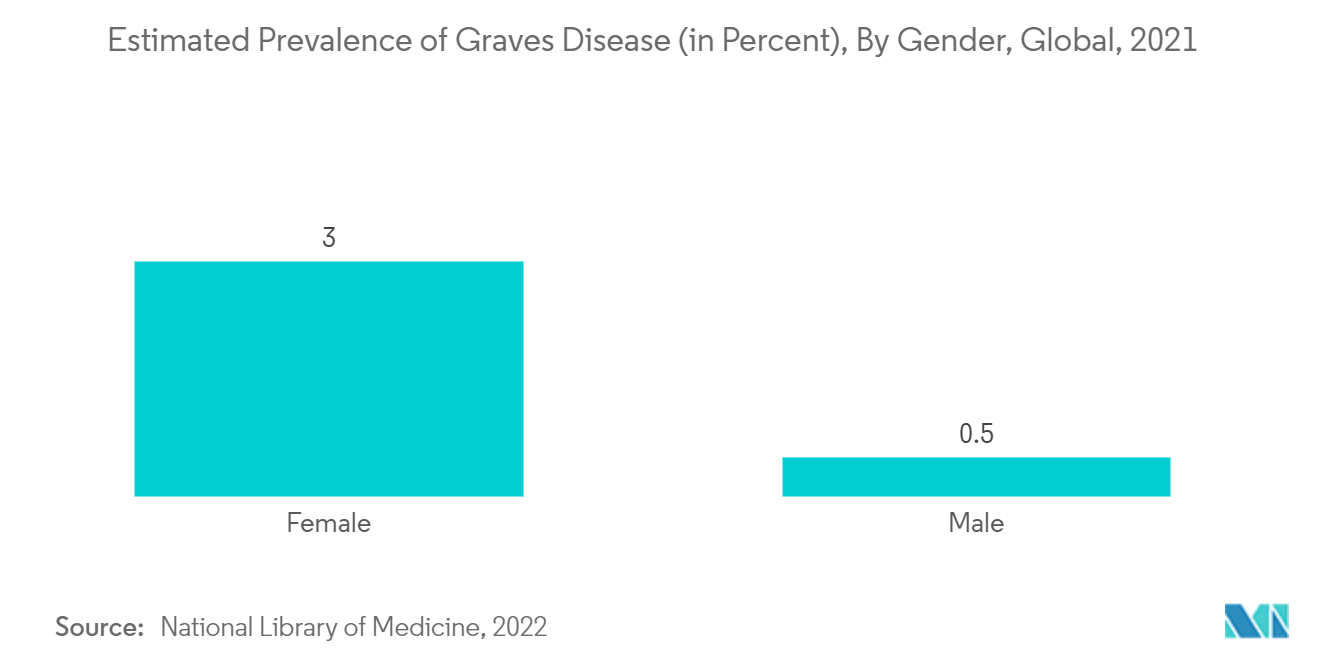
North America Expected to Hold a Significant Market Share
The primary driving factors for the growth of the North American Graves' disease market are the rising prevalence of Graves' disease, the growing burden of hyperthyroidism, and the increased funding for rare diseases. The high prevalence of thyroid disorders, significant awareness about thyroid treatment and diagnosis, and availability of various treatment options due to advanced healthcare infrastructure are some key factors contributing to the region's significant growth.
The United States within North America is expected to hold a significant share of the studied market during the study period. For instance, according to the article 'What is the Prevalence of Graves' Disease in the US?' published in April 2020, Graves' disease is the most common cause of hyperthyroidism in the United States, and the incidence rate of Graves' disease is estimated to be approximately 30 cases per 100,000 persons per year. The burden of GD is significantly high, which is expected to increase the demand for its therapeutics and diagnosis, which will boost the studied market growth.
According to the article 'Graves' Disease,' updated in July 2021 and published in the National Library of Medicine, the prevalence of hyperthyroidism in the United States is 1.2%, with an incidence of 20/100,000 to 50/100,000. Although GD is a rare disease, it is creating a burden on the healthcare industry in the country, which will encourage the diagnosis and research studies in the market, thereby propelling the market.
According to the study 'Beta blockers in the treatment of hyperthyroidism,' updated in October 2021, propranolol in high doses (above 160 mg/day) slowly decreases serum triiodothyronine (T3) concentrations by as much as 30% via inhibition of the 5'-monodeiodinase that converts thyroxine (T4) to T3. This study indicates that beta blocker propranolol decreases the amount of thyroid and suppresses the activity of the thyroid gland, thereby increasing its adoption thus, driving the market.
Therefore, the studied market is expected to lead to lucrative growth in North America due to the aforementioned factors.
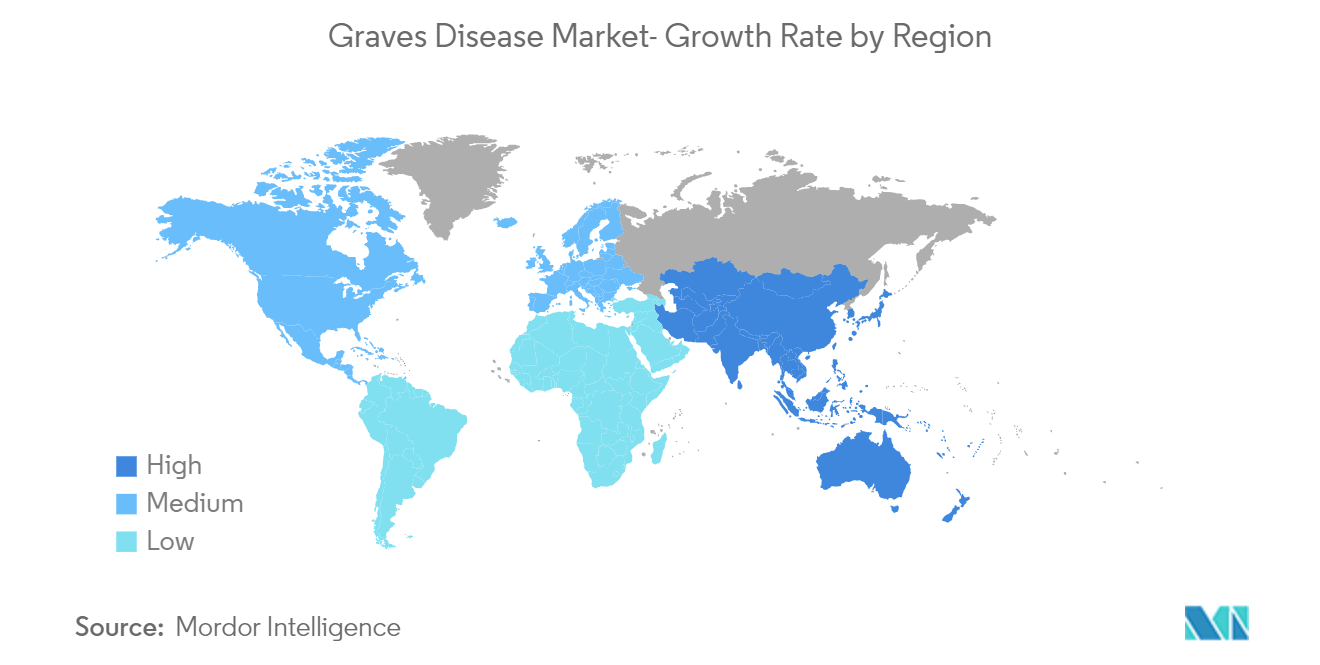
Graves Disease Industry Overview
The Graves' disease market is fragmented and moderately competitive. The strategies such as mergers, acquisitions, and partnerships adopted by key players will propel market growth. The key players in the market are Pfizer, Abbott, Thermo Fisher Scientific Inc., Jubiliant Pharma Holdings Inc., F. Hoffmann-La Roche Ltd., and Others.
Graves Disease Market Leaders
-
Pfizer
-
F. Hoffmann-La Roche Ltd.
-
Abbott
-
Thermo Fisher Scientific Inc.
-
Jubilant Pharma Holdings Inc.
*Disclaimer: Major Players sorted in no particular order
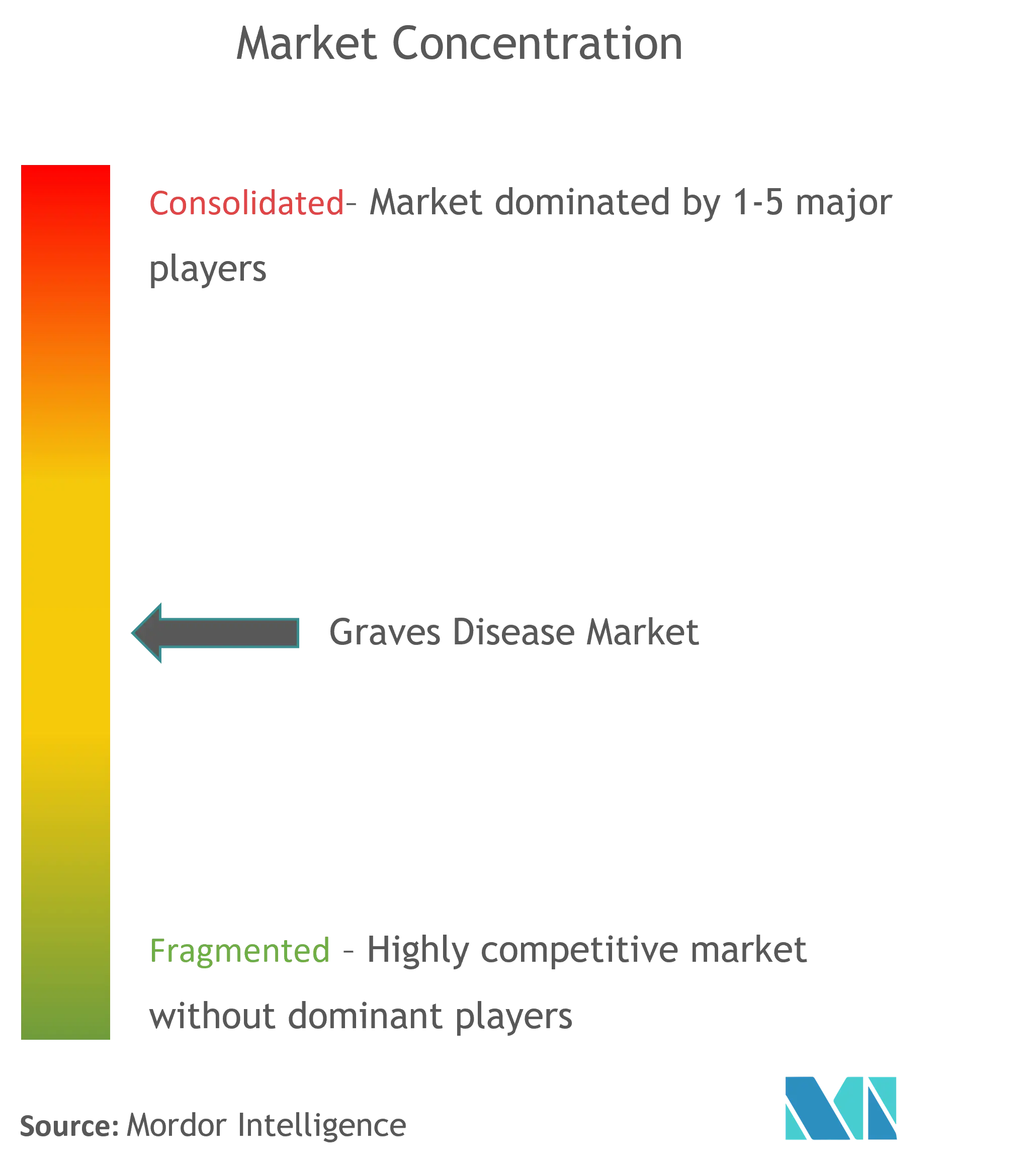
Graves Disease Market News
- In June 2022, Sling Therapeutics, Inc., a biopharmaceutical company launched a USD 35 million Series A financing led by TPG's The Rise Fund. The funds will support a Phase 2b clinical trial evaluating the company's investigational drug, linsitinib, for the treatment of thyroid eye disease (TED). TED predominantly affects women, and most frequently affects people with hyperthyroidism due to Graves' disease.
- In May 2022, Mindray launched the TRAb assay for Graves' disease diagnosis and management. TRAb (thyrotropin receptor antibody) is the pathogenic antibody of Graves' disease, TRAb is considered to be one of the most important serum biomarkers for diagnosis.
Graves Disease Market Report - Table of Contents
1. INTRODUCTION
- 1.1 Study Assumptions and Market Definition
- 1.2 Scope of the Study
2. RESEARCH METHODOLOGY
3. EXECUTIVE SUMMARY
4. MARKET DYNAMICS
- 4.1 Market Overview
-
4.2 Market Drivers
- 4.2.1 Increasing Prevalance of Hyperthyroidism
- 4.2.2 Increasing Funding for Rare Diseases
-
4.3 Market Restraints
- 4.3.1 High Cost of Treatment
-
4.4 Porter's Five Forces Analysis
- 4.4.1 Threat of New Entrants
- 4.4.2 Bargaining Power of Buyers/Consumers
- 4.4.3 Bargaining Power of Suppliers
- 4.4.4 Threat of Substitute Products
- 4.4.5 Intensity of Competitive Rivalry
5. MARKET SEGMENTATION (Market Size by Value - in USD Million)
-
5.1 By Diagnosis
- 5.1.1 Ultrasound
- 5.1.2 Imaging Test
- 5.1.3 Radioactive Iodine Uptake
- 5.1.4 Blood Sample
-
5.2 By Treatment
- 5.2.1 Anti-Thyroid Medication
- 5.2.2 Radioactive Iodine Therapy
- 5.2.3 Surgery
-
5.3 Geography
- 5.3.1 North America
- 5.3.2 Europe
- 5.3.3 Asia-Pacific
- 5.3.4 Middle-East and Africa
- 5.3.5 South America
6. COMPETITIVE LANDSCAPE
-
6.1 Company Profiles
- 6.1.1 Pfizer
- 6.1.2 F. Hoffmann-La Roche Ltd.
- 6.1.3 Abbott
- 6.1.4 Thermo Fisher Scientific Inc.
- 6.1.5 Jubilant Pharma Holdings Inc.
- 6.1.6 Novartis
- 6.1.7 Sun Pharma
- 6.1.8 Institute of Isotopes Co. Ltd.
- 6.1.9 bioMerieux SA
- 6.1.10 Horizon Therapeutics Ireland DAC
- *List Not Exhaustive
7. MARKET OPPORTUNITIES AND FUTURE TRENDS
** Subject To AvailablityGraves Disease Industry Segmentation
As per the report's scope, Graves' disease is an immune system disorder that results in the overproduction of thyroid hormones (hyperthyroidism). The sub-divisions of Graves' Disease are Graves dermopathy, Graves Orbitopathy, and Graves Ophthalmopathy, also known as thyroid eye disease.
The Graves Disease Market is Segmented by Diagnosis (Ultrasound, Imaging Test, Radioactive Iodine Uptake, and Blood Sample), by Treatment (Anti-thyroid Medication, Radioactive Iodine Therapy, and Surgery), and by Geography (North America, Europe, Asia-Pacific, Middle-East and Africa, and South America). The report offers the value (USD million) for the above segments.
| By Diagnosis | Ultrasound |
| Imaging Test | |
| Radioactive Iodine Uptake | |
| Blood Sample | |
| By Treatment | Anti-Thyroid Medication |
| Radioactive Iodine Therapy | |
| Surgery | |
| Geography | North America |
| Europe | |
| Asia-Pacific | |
| Middle-East and Africa | |
| South America |
Graves Disease Market Research FAQs
What is the current Graves Disease Market size?
The Graves Disease Market is projected to register a CAGR of 4.20% during the forecast period (2024-2029)
Who are the key players in Graves Disease Market?
Pfizer, F. Hoffmann-La Roche Ltd., Abbott, Thermo Fisher Scientific Inc. and Jubilant Pharma Holdings Inc. are the major companies operating in the Graves Disease Market.
Which is the fastest growing region in Graves Disease Market?
Asia-Pacific is estimated to grow at the highest CAGR over the forecast period (2024-2029).
Which region has the biggest share in Graves Disease Market?
In 2024, the North America accounts for the largest market share in Graves Disease Market.
What years does this Graves Disease Market cover?
The report covers the Graves Disease Market historical market size for years: 2019, 2020, 2021, 2022 and 2023. The report also forecasts the Graves Disease Market size for years: 2024, 2025, 2026, 2027, 2028 and 2029.
Graves Disease Industry Report
Statistics for the 2024 Graves Disease market share, size and revenue growth rate, created by Mordor Intelligence™ Industry Reports. Graves Disease analysis includes a market forecast outlook to for 2024 to 2029 and historical overview. Get a sample of this industry analysis as a free report PDF download.



